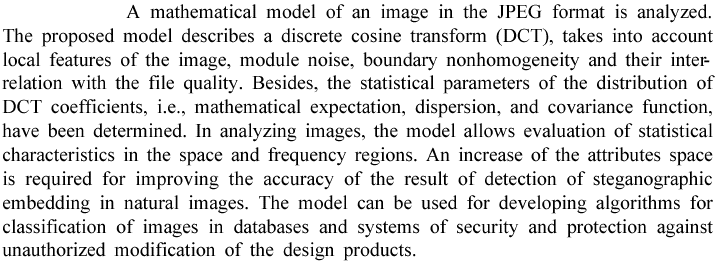A. Usikov Institute of Radio Physics and Electronics,
National Academy of Sciences of Ukraine
12, Academician Proskura Str., Kharkiv 61085, Ukraine
Influence of the Upper Layer of Soil on the CM and MM Radio Waves Backscattering
The specific of centimeter and millimeter radio waves backscattering by the soil stipulated by the layer-like structure of its moisture upon the depth and the spatial fluctuations of dielectric permeability of the upper layer of the soil have been analyzed with respect of remote sensing from aerospace carriers. The quantity estimates are provided for 3-cm and 8-mm radio waves. The strong influence of sharp alterations of soil moisture that can exist at the depth of units of millimeters upon the backscattering is demonstrated.
National Aerospace University,
1, Cosmonaut Komarov Avenue, 03058, Kyiv, Ukraine
Technical University Hamburg-Harburg
40 Eissendorfer Str., Hamburg, 21073, Germany
Precipitation and Turbulence Intensity Classification Based on the Polarimetric Doppler Radar Data Analysis
This paper briefly describes methodology of precipitation and turbulence classification based on data retrieved by the Doppler-polarimetric radar. Not only classical parameters of turbulence such as eddy dissipation rate are integrated into classification procedure but also the polarimetric ones and the parameters based on the averaged Doppler velocities analysis. The technical complexity of this procedure and scientific importance of this problem are obvious. The classification procedure based on fuzzy logic takes place after detailed processing of echo signal and informative parameters computation. This allows us to distinguish between different types of precipitation and turbulence intensities. The classifier makes the decision about precipitation type and turbulent motion intensity based on simultaneous analysis of all of the informative parameters.
A Technique for Estimating the Required Flow Rate of Three-Dimensional TV Signals
A technique is suggested for estimating the required rate of digital data flow which allows evaluating compression algorithms for three-dimensional pictures. The flow rate estimation procedure is presented through the example of a compression algorithm with compensated parallax.
Assessment of the Signal/Noise Ratio of Received Nose-Like Signals in Channels with Signal Depression and an Unstable System of Clock Synchronization

Mathematical Model of a Digital Image in the JPEG Format

A. Usikov Institute of Radio Physics and Electronics,
National Academy of Sciences of Ukraine
12, Academician Proskura Str., Kharkiv 61085, Ukraine
Propagation of Femtosecond Pulses along Lightwave Communicative Systems
The influence of higher-order dispersive and nonlinear effects on propagation of pulses along optics fibers is investigated. An approach based on the Fokker-Planck equation using the first-order adiabatic perturbation theory is presented to study the statistical properties of parameters of ultrashort pulse in the presence of amplifier spontaneous emission. This method allows to recept directly the probability density function by solving the Fokker-Planck equation. In particular, the analytical calculation of the dependence of jitter of femtosecond soliton parameters on propagation distance is given. It can be concluded, that the influence of higher-order effects like nonlinear dispersion, third-order dispersion and the intrapulse Raman scattering tend to increase the jitter of soliton parameters.
Development of an Approach to Analysis of Frequency Properties of Mutidimensional Signal-Code Structures Built on a Simplex Basis

Conversion of the Positional Binary Code into the Code of Modular Number System
The method of decreasing the time of binary positional code conversion into the code of modular number system (MNS) in the converter based on the coherent modular summator has been suggested. The noise tolerance of the converter depending on signal – noise ratio and MNS radix size has been investigated.
On Electronic Formation of Directivity Characteristics of a Microphone

Interference Immunity of Directional Microphones
